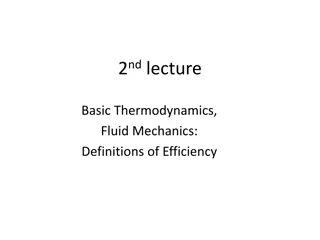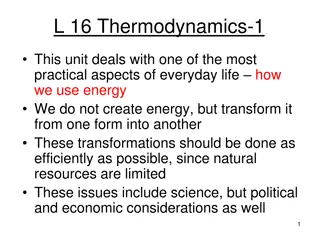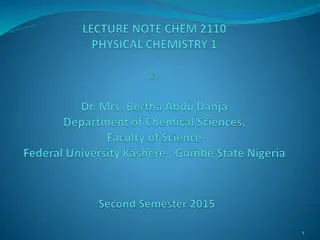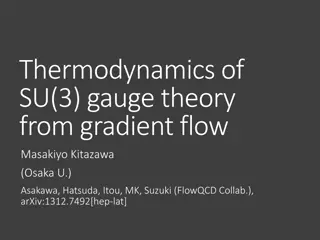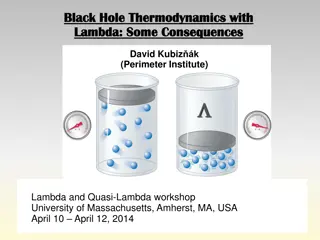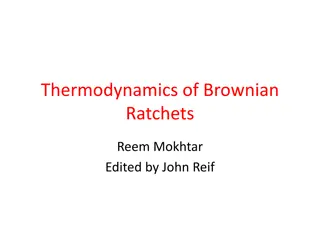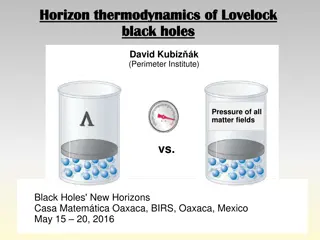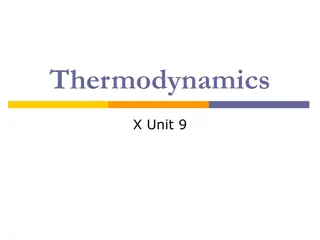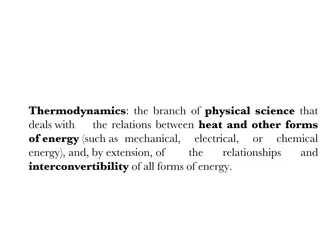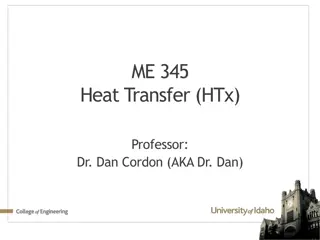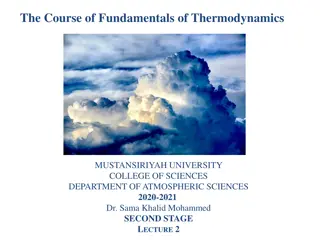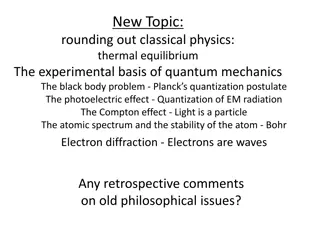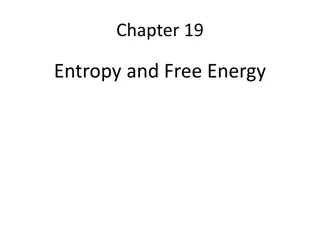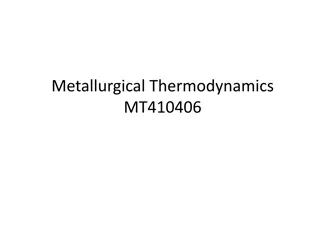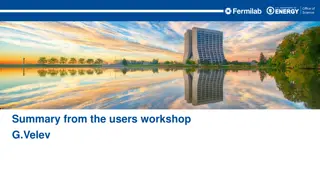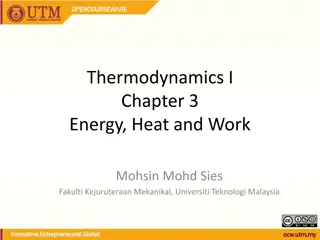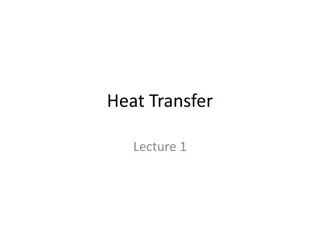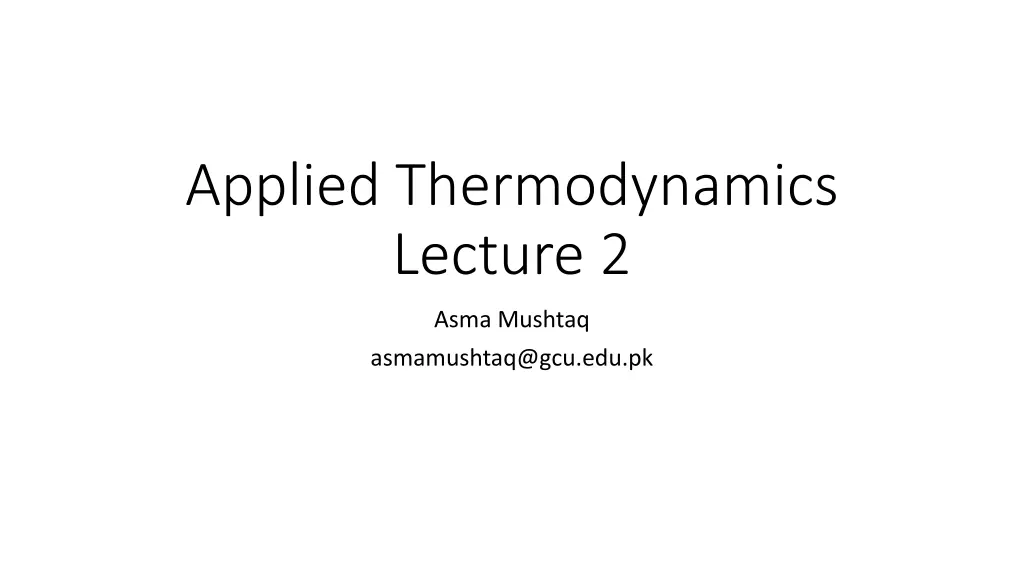
Understanding Thermodynamics
Explore the concepts of reversible and irreversible processes in thermodynamics, including the differences between volume and specific volume. Learn about the criteria for reversibility and the essential properties of these fundamental principles.
Download Presentation

Please find below an Image/Link to download the presentation.
The content on the website is provided AS IS for your information and personal use only. It may not be sold, licensed, or shared on other websites without obtaining consent from the author. If you encounter any issues during the download, it is possible that the publisher has removed the file from their server.
You are allowed to download the files provided on this website for personal or commercial use, subject to the condition that they are used lawfully. All files are the property of their respective owners.
The content on the website is provided AS IS for your information and personal use only. It may not be sold, licensed, or shared on other websites without obtaining consent from the author.
E N D
Presentation Transcript
Applied Thermodynamics Lecture 2 Asma Mushtaq asmamushtaq@gcu.edu.pk
Difference between Volume (V) and Specific Volume (v) Volume (V): Refers to the total amount of three-dimensional space occupied by a substance or system. It's an extensive property, meaning it depends on the amount of substance present. The unit of volume is typically cubic meters (m ) or liters (L). Specific Volume (v): Defined as the volume per unit mass of a substance. It's an intensive property, meaning it is independent of the amount of substance. Specific volume is the reciprocal of density: v=1/ where V is the total volume, m is the mass, and is the density. The unit of specific volume is typically cubic meters per kilogram (m /kg). In summary, volume is the total space a substance occupies, while specific volume is the volume occupied per unit mass of that substance.
Reversible Process When a system changes state in such a way that at any instant during the process the state point can be located on the diagram, then the process is said to be reversible. The fluid undergoing the process passes through a continuous series of equilibrium states. A reversible process is shown as a line on any diagram of properties. Practically the fluid undergoing a process can not be kept in equilibrium in its intermediate states and a continuous path can not be traced on a diagram of properties. Such real processes are called irreversible processes.
Irreversible process An irreversible process is usually represented by a dotted line joining the end states to indicate that the intermediate states are indeterminate.
Criteria for Reversibility When a fluid undergoes a reversible process, both the fluid and its surroundings can always be restored to their original state. The criteria for reversibility is as follows: 1. The process must be frictionless. The fluid itself must have no internal friction and there must be no mechanical friction (e.g. between cylinder and piston). 2. The difference in pressure between the fluid and its surroundings during the process must be infinitely small. This means that the process must take place infinitely slowly, since the force to accelerate the boundaries of the system is infinitely small.
Criteria for Reversibility 3. The difference in temperature between the fluid and its surroundings during the process must be infinitely small. This means that the heat supplied or rejected to or from the fluid must be transferred infinitely slowly. No process in practice is truly reversible. In an internally reversible process, although the surroundings can never be restored to their original state, the fluid itself is at all times in an equilibrium state and the path of the process can be exactly replaced to the initial state. In general, processes in cylinders with a reciprocating piston are assumed to be internally reversible as a reasonable approximation, but process in rotary machinery (e.g. turbines) are known to be irreversible due to the high degree of turbulence and scrubbing of the fluid.
Examples of internal reversibility Ideal gases: Processes involving ideal gases are often considered internally reversible, as they are assumed to have no internal friction and follow the ideal gas law. Consider a gas trapped inside a cylinder with a movable piston. If you very slowly pull the piston out, the gas inside will expand. During this process: If you expand the piston extremely slowly, the gas adjusts its pressure and volume step-by-step, and at each moment, the pressure and temperature throughout the gas are uniform.
Examples of internal reversibility Since the process is happening gradually, the gas passes through a series of equilibrium states, meaning at each small step, the system is in balance internally (no unbalanced forces or rapid changes). Quasi-static compression: If a gas is compressed slowly enough that it remains in thermal equilibrium with its surroundings, the process can be considered internally reversible.
Example of Reversible process Consider an ideal frictionless fluid contained in a cylinder behind a piston. Assume that the pressure and temperature of the fluid are uniform and that there is no friction between the piston and the cylinder walls. Let the cross-sectional area of the piston be A, let the pressure of the fluid be p, let the pressure of the surroundings be (p + dp). The force exerted by the piston on the fluid is pA. Let the piston move under the action of the force exerted a distance dl to the left. Then work done on the fluid by the piston is given by force times the distance moved, i.e. Work done, dW = -(pA) x dl=-p.dv
where dV is a small increase in volume. The negative sign is necessary because the volume is decreasing. Or for a mass, m, dw= -mp dv where v is the specific volume. When a fluid undergoes a reversible process a series of state points can be joined up to form a line on a diagram of properties. The work done on the fluid during any reversible process, W, is therefore given by the area under the line of the process plotted on a p-v diagram. W = -mpdv
A process from right to left on the pv diagram is one in which there is a work input to the fluid (ie. W is positive). Conversely, a process from left to right is one in which there is a work output from the fluid (ie. W is negative). When a fluid undergoes a series of process and finally returns to its initial state, then it is said to have undergone a thermodynamic cycle. A cycle which consists only of reversible processes is a reversible cycle. A cycle plotted on a diagram of properties forms a closed figure, and a reversible cycle plotted on a p-v diagram forms a closed figure the area of which represents the net work of the cycle. For example, a reversible cycle consisting of four reversible processes 1 to 2, 2 to 3, 3 to 4, and 4 to 1 is shown in Figure. The net work input is equal to the shaded area. If the cycle were described in the reverse direction (ie. 1 to 4, 4 to 3, 3 to 2, and 2 to 1), then the shaded area would represent net work output from the system. The rule is that the enclosed area of a reversible cycle represents net work input (i.e. net work done on the system) when the cycle is described in an anticlockwise manner, and the enclosed area represents work output (i.c. work done by the system) when the cycle is described in a clockwise manner.

